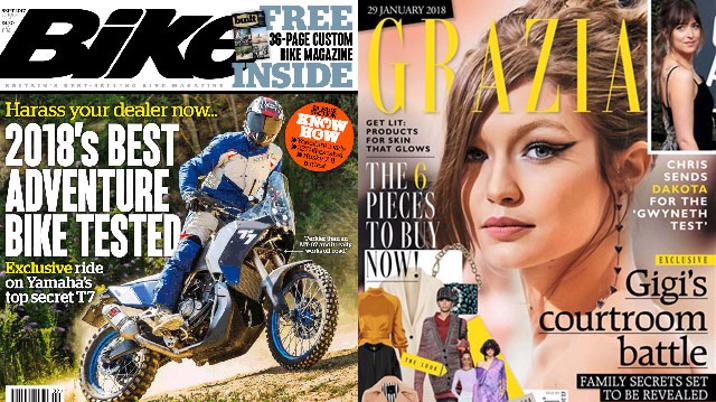
The great thing about 2018, as far as I'm concerned, is that the business I run for Bauer has now grown to such an extent that, for the first time, we've been given a decent marketing budget in the P&L to try and boost growth. Following a 2017 where we grew revenues by 20 per cent year-on-year, such an investment seems worthy. We'll not go wild with the cash – every penny will have to be justified and ROI analysed weekly – but it should help us grow even more and, more importantly, learn.
In the second half of 2017, on some titles – by no means all – we started to see a decline in views of our App Store pages, and with it, a decline in app installs, with the inevitable consequence that paid subscription revenues from iTunes stagnated.
I felt that one of the principle reasons for this wasn't necessarily because the market for these titles was declining, more that search and performance within the iOS App Store was becoming more complex to manage – and with only one full-time marketer on the team, some of our key titles just weren't getting the attention they merited.
Consequently, where a title like Grazia used to consistently appear in the top 10 of the 'paid' app chart under the old 'Magazines and Newspapers' category, in the new iOS 11 App Store, it had fallen badly off the radar (though the decline had started before Apple made the changes it did to their online marketplace).
Hence, a hypothesis was formed, which, neatly summarised, stated that, by hiring some outside expertise to assist, we could try and reach a bigger audience within the App Store and start to grow installs again. Then, most importantly of all, simultaneously we can improve the conversion funnel to paid subs by running some classy marketing campaigns and CRM in the app.
So, we're now half-way through a two-title test marketing campaign we launched with a specialist app marketing agency, and the results thus far are interesting. Once the test is over, we'll look to roll out the learnings more widely across the greater portfolio of Bauer titles in both the iOS and Google app stores.
Our test features two titles that couldn't be more different if you wanted them to be, namely Bike and Grazia. Both offer fabulously crafted, interactive experiences; we've always been convinced that stagnation in installs hasn't been about the quality of the product, more about how easy it is to find them and then persuade people to download and look at them.
So, by improving our organic search performance alongside a paid-search campaign, we should soon understand whether this hypothesis holds any water.
Frankly speaking
The agency was pretty blunt in its observations.
“Your screenshots are sub-optimal,” they said, before providing recommendations on how to alter them (which, incidentally, wasn't that dissimilar to how you persuade people via a print front cover to physically pick up a magazine in a newsagent - ie. like a cover, via your screenshots and app title, you have a second or two to persuade people to click through to your App Store page, once their search has made your app visible. Then, perhaps you have another second or two to get the brand message across to the user and, hopefully, persuade them to install).
“Why don't you have a video preview of the app?” the agency asked. Our muttered excuse of an answer, “lack of resource,” cut no mustard with them. Resource suddenly became available and video previews, made along strict specs and guidelines, were constructed, before being altered, altered again according to the agency's advice, and uploaded.
It was easy to do – sometimes, it's far too convenient to make excuses rather than push yourself out of your comfort zone. Decline is the inevitable consequence of inaction and staying still in any digital arena. The App Store is no different, and video previews really help grab the user's attention and show what your app and its content is all about.
Other instructions were forthcoming. “Your app titles are too short,” they said. So, they suggested changes, and we made them.
Keyword analysis was undertaken and keywords were changed accordingly. More of these keywords were added to the main app description. Repeatedly.
Before, we'd kind of guessed what terms would be popular in App Store search. We didn't have the tools to find out otherwise. Now, though, we knew. And we know. And we'll continue to monitor and change regularly, based on performance, just as you would do when search optimising a website. The principles are little different.
“Do you have a strategy to gain good app ratings?” We were asked. A cough and a splutter later, and our strategy was found out also to be behind the times. So, we updated it, delaying sending push notification requests until after users had downloaded a free issue, following install; then serving a request to give us a five-star rating (via a built-in link to the App Store) only when an issue had been downloaded.
In parallel to all this, we've run some paid search campaigns on various keywords, too. You have to be a little careful here as doing this can skew results – ie. many users will find the app organically but then tap on the advert – but we wanted to open up the app to as big an audience as possible, to ascertain the potential size of the prize within the app stores.
All this work was implemented via app updates released in December, to take advantage of the Christmas glut of installs.
We're running it through to the end of January, then analysing the results to see what works and what doesn't. Initial results, though, are more than encouraging, with clicks through to our app pages up significantly, and installs following suit. Our ratings are improving and both Bike and Grazia are climbing the rankings and benefiting from the improved visibility that brings as a consequence.
Currently, our cost per subscription acquisition is way too high, but we're selling 60-day free trials, so revenues aren't going to really start growing until the end of the first quarter of 2018.
Too often, I hear publishers say, “there isn't the demand for our titles in a digital format.” But it's all too easy and convenient to say such things, or to make excuses for inaction based on poor (or no) analytics from an app that's been rolled out and left to fester. You only need to look through publisher apps on the app stores (some, I hasten to add, ours) to see laziness coming to the fore.
As a caveat, yes, some titles' reader demographics mean they might not work as an app, yet. But there are many that will.
So now, more than ever, if you're to keep on getting people to install your app and engage with it, not only do you need a great app and content to start with, but your marketing and your understanding of the analytics needs to be totally on point – and managed, via reporting on trends and performance, astutely. And regularly.










